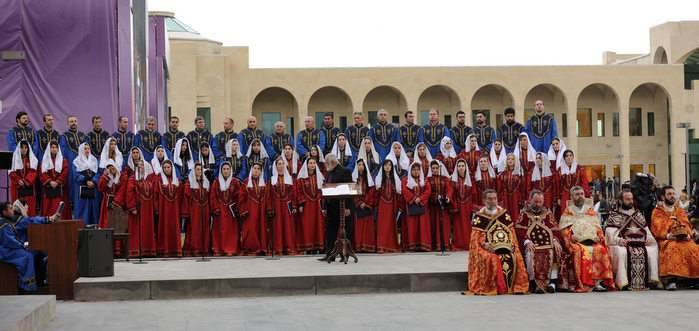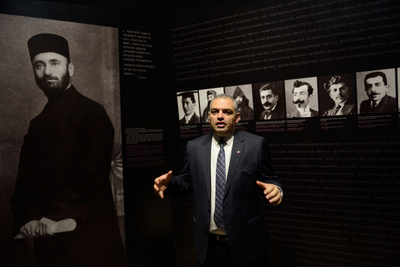Soykırım Müzesi’nden Eçmiyadzin’e Yerevan’da yüzyıllık ‘bir’ gün


Hrant Dink Vakfı’nın 2009’dan bu yana yürüttüğü ‘Türkiye-Ermenistan Gazeteci Diyalog Programı’ kapsamında 20-25 Nisan tarihlerini soykırım anmalarının kalbinin attığı yerde, Yerevan’da geçirdik. Hürriyet’ten Cansu Çamlıbel, Milliyet’ten Kadri Gürsel, Cumhuriyet’ten Ceyda Karan, 360tv’den Hilmi Hacaloğlu, CNNTürk’ten Damla Doğan, KanalD Haber’den Fulya Soybaş, Yeni Şafak’tan Kübra Kara, Star’dan Selim Efe Erdem ve Sabah’tan Ali Oktay’ın katılımıyla yüzüncü yıl atmosferini gözlemleme fırsatı bulduk.
23 Nisan’da, Tsitsernakaberd’de (Kırlangıç Tepesi) bulunan ve üç yıldır tadilatta olup kapılarını 25 Nisan 2015’te yeniden ziyarete açan Soykırım Müzesi’ni, müzenin direktörü Hayk Demoyan’ın ilgili rehberliği ile, bizler için özel olarak organize ettiği yaklaşık 2 saat boyunca süren turla gezdik.
Restorasyon sürecinin ardından müze bambaşka bir tasarıma ve dijitalleşmenin verdiği olanaklarla da üstün bir standarta ulaşmış. Müze alanı iki buçuk kat arttırılarak, 2500 m2’ye çıkarılmış. Toplam 12 galeri, 50 bölüm ve 90.000 parçadan oluşan müze, ziyaretçileri çok katmanlı ve birçok durağa sahip bir bellek yolculuğuna çıkartıyor.

Enver Paşa’nın ıslak imzalı belgesi
İlk pano, ‘Osmanlı İmparatorluğu’nda ve Batı Ermenistan’da Ermeniler’ başlığı ile karşılıyor bizi. Bu bölümde 1915 öncesindeki ortak yaşamdan fotoğraf, obje ve verilere yer veriliyor.
Diğer panolarda nelerin geleceğini tahmin etmek zor değil, 1894-1896 arasındaki Hamidiye alaylarının katliamları, 1909 Adana katliamı, I. Dünya Savaşı ve tabii ki 1915 ve sonrası… Demoyan, orijinal bir belgeyi özel olarak getirterek bize gösterme nezaketinde bulunuyor. O ıslak imzalı belge ise, Harbiye Nazırı olan Enver Paşa’nın Osmanlı ordusunda savaşan Ermeni komutan Sarkis Torosyan’a üstün başarıları nedeniyle yazdığı takdirname.
Algıda giderek siyahlaşan panolar 1915 ve sonrasında kapkaranlık oluyor… Aydınlarla başlıyor 1915; onların fotoğrafları ve ailelerine yazdıkları son mektuplardan birkaçının orijinali de müzede sergileniyor. Sonrası ise çıkmaz sokak, kademe kademe artan zulmün fotoğrafları…Van’da çarmıha gerilmiş bir çocuğun ellerini gösterdiği fotoğraf, çölde hayvanlarla çok uzun süre yaşadığı için çakal gibi davranıp, insanları ısıran çocuğun Halep’te çekilmiş can yakan fotoğrafları ‘kadın ve çocuklara’ ayrılmış bölümde yer alıyor.
Müzede yer alan objeler de vurucu, tıpkı 1915’de Türk askeri tarafından vurulan Hayganuş Eghikian’ın, 60 yıl boyunca göğsünün altında taşıdığı kurşun veya yetimhanelerde çocuklara verilen yüz yıllık 1 porsiyon pirinç gibi.
Müzenin en çarpıcı kısımlarından bir tanesi de Anadolu’nun kültürel mirasının geçmişini ve bugününü yansıtan dijital panolar. Birçok yapının 1915 öncesi halini ve bugünkü durumunu görmek bir ülkenin ne denli çoraklaştığını ve metruklaştığını anlamak açısından gayet çarpıcı.
Hrant Dink cinayeti de müzede
En son pano Hrant Dink cinayetine ayrılmış; olay mahalinden fotoğraf, Ogün Samast’ın karakoldaki malum fotosu ve yüzbin kişinin yürüyüşünün fotoğraflarıyla final yapıyoruz. Hayk Demoyan “Hrant Dink’in öldürülmesi çok trajikti, biz bu trajediyi göstermek ama aynı zamanda umudu da yansıtmak istedik. O gün orada yürüyen onbinler halen azınlık ama biz onların sayısının artmasını umut ediyoruz” diyerek bize mesajını veriyor.
Soykırım müzesini gezmek, orada yüzyılı aşkın bir hakikate tanıklık etmek kolay değil. Müzeden çıkınca yöneldiğiniz soykırım anıtında ise biriktirdiğiniz tüm duygular orada yanan ateşe karışıyor.
Eçmiyadzin’de dua ve ötesi…
Yine aynı gün, saat 17:00’de başlayacak, yüzyılın en anlamlı ayinlerinden birisine katılmak için kutsal Eçmiyadzin Kilisesi’ne doğru yola çıkıyoruz.
Tören açık havada yapılıyor. Dünyanın dört bir yanından gelen din adamları kiliseden çanlar eşliğinde çıkmaya başlıyor. Tüm Ermeniler Katolikosluğu Patriği Karekin II’nin de gelmesi ile halk din adamlarının arkasına katılıyor ve açık alandaki mihraba doğru yürüyor.
Yaklaşık 600-700 kişilik bölüme davetiye sahibi davetliler giriş yapabiliyor. O alanın dışında kalan yerde ise halk dev ekranlardan kah ayakta kah çimenlerin üzerinde oturarak ayini izleme fırsatı buluyor. Fransa’dan, Arjantin’e; İran’dan, Amerika’ya; Uruguay’dan, Avustralya’ya kadar dünyanın dört bir yanından Ermeni ile hep birlikte dualar göğe yükseliyor.
Tüm Ermeniler Katolikosluğu Patriği Karekin II yaptığı duygusal konuşmada “Ermeni soykırımın dehşet günlerinde, milyonlarca insanımız yerinden edildi ve katledildi, ateş ve kılıçtan geçti, işkence ve acının acı meyvelerinden tattı. Soykırım şehitlerimizin aziz ilan edilmesi, milli ve dini hayatımıza yeni bir hayat, yeni bir nefes, kutsiyet ve onur bahşediyor” dedi.
Saat 19.00’da dünyanın dört bir yanından kiliselere canlı bağlanılmaya başlandı. Papa Francesco’nun ekranda yansımasıyla da minnet dolu büyük bir alkış koptu. İstanbul’da çanların çalınmaması ve yüz yıl önce olay mahali olan coğrafyadaki sessizlik, yitirdiklerimizin de anısını düşününce yürek burkucu oldu. Saat 19:15 olduğunda ise çanlar yine akan kilise görüntülerinin eşliğinde, beş dakika boyunca yüz kere çaldı ve binlerce kişi lâl olup, sessiz dualarını yitirdiklerine gönderdi.


